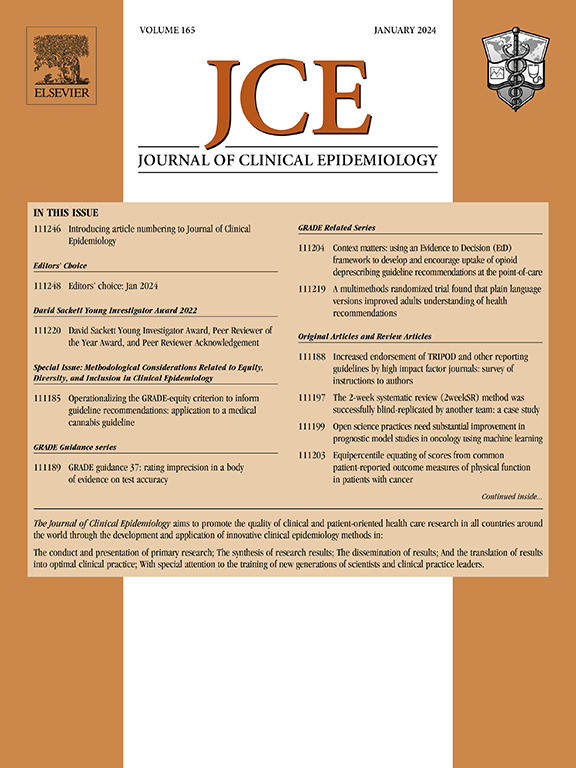核心结局集发展中的患者研究伙伴:系统回顾。
IF 5.2
2区 医学
Q1 HEALTH CARE SCIENCES & SERVICES
引用次数: 0
摘要
背景:核心结果集(COS)是特定健康或医疗保健领域的临床试验应报告的最小结果集。患者研究伙伴(PRPs)应参与COS开发的所有阶段(共同领导和共同开发COS)。prp提供了一种疾病的生活经验,这种观点可以提高COSs的质量和吸收。然而,PRP的职责存在可变性,这可能会阻碍对COS开发的有意义的参与。目的:系统地回顾PRPs在COS发展研究中的作用,并将其参与策略与现有指导进行比较。方法:我们纳入了正在进行和已完成的涉及PRPs的COS发展的英文研究。我们在2023年9月15日搜索了Medline, Embase和Web of Science。我们应用COS- standards for Development (COS- stad)来评估COS的质量。我们提取、制表和描述COS发展研究的细节。结果:我们检索了2261条独特记录,其中94篇文章描述了64项COS发展研究。最早的出版物是在2014年。41项(64%)研究在设计COS发展的患者参与时引用了有效性试验的核心结果测量(COMET)手册。在研究团队成员中,引用COMET手册的研究中PRPs的比例(17%)与未引用COMET手册的研究中PRPs的比例(17%)相似。69%的研究包括prp,但没有特别包括这个术语,31%的研究还涉及prp在其他活动中,如德尔菲研究和访谈。这些研究描述了各种PRP任务,其中最常见的是指导过程(70%)和设计问卷(64%)。结论:本系统综述确定了现有COS研究中PRP术语、角色和参与的差异。我们建议研究人员参考已建立的指南,如COMET手册,以获得一致的PRP术语和定义。这种指导还有助于确定适当的途径,使患者在整个COS开发过程中成为合作伙伴。这些发现为未来的PRP参与奠定了基础,旨在平衡COS发展中有意义的参与与可行性。本文章由计算机程序翻译,如有差异,请以英文原文为准。
Patient research partners in core outcome set development: a systematic review
Background and Objectives
A core outcome set (COS) is a minimal set of outcomes that clinical trials in a specific health or health-care area should report. Patient research partners (PRPs) should engage in all stages of COS development (coleading and codeveloping the COS). PRPs contribute the lived experience of a condition, and this perspective can improve the quality and uptake of COSs. However, there is variability in PRP responsibilities, which can impede meaningful involvement in COS development. The study aims to systematically review the roles of PRPs in COS development studies and compare their involvement strategies with available guidance.
Methods
We included ongoing and completed COS development studies published in English that involved PRPs. We searched Medline, Embase, and Web of Science on September 15, 2023. We applied COS-Standards for Development to assess the quality of the COS. We extracted, tabulated, and described details of the COS development studies.
Results
Our searches identified 2261 unique records, of which we included 94 articles describing 64 COS development studies. The earliest publication was in 2014. Forty-one (64%) studies cited the Core Outcome Measures in Effectiveness Trials (COMET) Handbook when designing patient engagement for COS development. Among research team members, the proportion who was PRPs was similar in studies that cited the COMET Handbook (17%) and in those that did not (17%). Sixty-nine percent of studies included PRPs but did not specifically include this nomenclature, and 31% also involved PRPs in other activities, such as Delphi studies and interviews. The studies described various PRP tasks, the most frequent of which were guiding the process (70%) and designing questionnaires (64%).
Conclusion
This systematic review identified variations in PRP terminology, roles, and engagement across existing COS studies. We recommend that researchers refer to established guidelines, such as the COMET Handbook, for consistent PRP terminology and definitions. Such guidance can also help identify appropriate avenues for engaging patients as partners throughout the COS development process. These findings lay the foundation for future PRP involvement, aiming to balance meaningful engagement with feasibility in COS development.
求助全文
通过发布文献求助,成功后即可免费获取论文全文。
去求助
来源期刊

Journal of Clinical Epidemiology
医学-公共卫生、环境卫生与职业卫生
CiteScore
12.00
自引率
6.90%
发文量
320
审稿时长
44 days
期刊介绍:
The Journal of Clinical Epidemiology strives to enhance the quality of clinical and patient-oriented healthcare research by advancing and applying innovative methods in conducting, presenting, synthesizing, disseminating, and translating research results into optimal clinical practice. Special emphasis is placed on training new generations of scientists and clinical practice leaders.
 求助内容:
求助内容: 应助结果提醒方式:
应助结果提醒方式:


